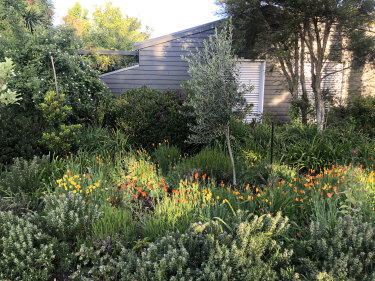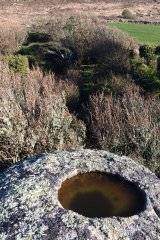Like many of us, Leon van Schaik took to his garden during last year’s pandemic lockdowns. He thought about gardens he had been in and gardens he had read about. He reflected on his travels, on his conversations with friends, about where he had lived and the places he had worked. He thought about how all this “spatial history” had fed into his 1400-square-metre Woodend patch. On top of that, the Emeritus Professor of Architecture at RMIT University began writing what came into his mind.

The Woodend garden created by Leon van Schaik is crammed with ideas.Credit:Leon van Schaik
For 30 years van Schaik’s academic work has centered on how an architect’s personal spatial experiences create an indelible stamp. His new book, Doing, Seeing; Seeing, Doing shows how it’s the same for designers of any space, landscapes included.
All of us have memories of particular gardens that can’t be shaken. It is not just how these gardens looked, but how they sounded and smelled, the way they were used and lived in, the tone they set. Invariably resonances work their way into your own space. This is not the same as transplanting a garden in one hit from one place to another. Van Schaik says that when gardeners are more aware of their spatial histories, they are less likely to apply fixed ideas that run counter to their site’s climate and context.
“Whenever this happens – when, for example, what in Japan would be subjected to meticulous daily grooming and seasonal adjustment, is simply set down and left sitting – the result rapidly becomes a parody,” he writes.

Leon van Schaik has been visiting ‘Eagles Nest’ in Cornwall, once the home of British artist Patrick Heron, since 1969.
Credit:Leon van Schaik
When van Schaik talks about how “every gardening act ricochets through other gardens” he is talking about the merest threads of different ideas flowing in.
“Our family histories, the gardens that we played in or worked in, the ways in which we have travelled, what we have experienced, and where we have dwelled and worked – all of these inflect our spatial thinking,” he writes.
His book details the broad sweep of his own personal influences, beginning with his childhood spent playing in his grandmother’s sunken garden in South Africa and his mother’s garden in England. Van Schaik, who is 76, remembers deadheading rhododendrons and azaleas at a grand English country estate as a schoolboy, and of periodically weeding and tilling a friend’s garden in Cornwall since his days as an architecture student in 1969.
There are all sorts of gardens that he has sampled in all sorts of ways. There are also the books he has read, the Monty Don television programs he has watched, the exchanges he has had with colleagues. It is, in short, a wide-roaming book that lays bare how our spatial experience steadily accumulates from a multitude of sources.
Stay connected with us on social media platform for instant update click here to join our Twitter, & Facebook
We are now on Telegram. Click here to join our channel (@TechiUpdate) and stay updated with the latest Technology headlines.
For all the latest Life Style News Click Here
For the latest news and updates, follow us on Google News.
